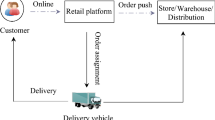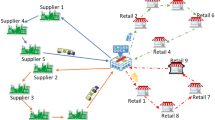Abstract
Commonly encountered in cold chain logistics, third-party distribution firms are required to deliver temperature-sensitive food products to various retailers with two kinds of time-window constraints: (1) the delivery service must begin within the time windows imposed by the retailers (called node time windows) and (2) each vehicle route is available only in a predefined time interval prescribed by the government (called arc time windows). We study the effects of the retailer time window type (i.e., density of the node time-window constraints) and other cost-related factors on a distribution firm’s legitimacy choice (i.e., the firm chooses to either comply with or violate the governmental time-window policy), food quality, and pollutant emissions in the urban environment. We model the problem as an intractable vehicle routing problem with node and arc time windows and develop a genetic algorithm to tackle it. We conduct a case study to generate the managerial insights on dealing with time windows. We find that the governmental time windows will increase the distribution cost. The governmental time windows has a negative effect on pollutant emissions while showing a positive effect on food safety. Given governmental time windows, a higher demand for node time windows will result in more governmental time-window violations or lower vehicle load factor, which depends on the vehicle fixed cost, fuel price, and government penalty.











Similar content being viewed by others
References
Al Chami, Z., Manier, H., & Manier, M. A. (2017). A lexicographic approach for the bi-objective selective pickup and delivery problem with time windows and paired demands. Annals of Operations Research. https://doi.org/10.1007/s10479-017-2500-9.
Amorim, P., & Almada-Lobo, B. (2014). The impact of food perishability issues in the vehicle routing problem. Computers & Industrial Engineering,67, 223–233.
Amorim, P., Belo-Filho, M. A. F., Toledo, F. M. B., Almeder, C., & Almada-Lobo, B. (2013). Lot sizing versus batching in the production and distribution planning of perishable goods. International Journal of Production Economics,146(1), 208–218.
Anderson, S., Allen, J., & Browne, M. (2005). Urban logistics: How can it meet policy makers’ sustainability objectives? Journal of Transport Geography,13(1), 71–81.
Baker, B. M., & Ayechew, M. A. (2003). A genetic algorithm for the vehicle routing problem. Computers & Operations Research,30(5), 787–800.
Belhaiza, S., Hansen, P., & Laporte, G. (2014). A hybrid variable neighborhood tabu search heuristic for the vehicle routing problem with multiple time windows. Computers & Operations Research,52, 269–281.
Bräysy, O., & Gendreau, M. (2005). Vehicle routing problem with time windows, part I: Route construction and local search algorithms. Transportation Science,39(1), 104–118.
Brito, J., Martinez, F. J., Moreno, J. A., & Verdegay, J. L. (2012). Fuzzy optimization for distribution of frozen food with imprecise times. Fuzzy Optimization and Decision Making,11(3), 337–349.
Çetinkaya, C., Karaoglan, I., & Gökçen, H. (2013). Two-stage vehicle routing problem with arc time windows: A mixed integer programming formulation and a heuristic approach. European Journal of Operational Research,230(3), 539–550.
Chen, C., Tian, Z., & Yao, B. (2017). Optimization of two-stage location–routing–inventory problem with time-windows in food distribution network. Annals of Operations Research. https://doi.org/10.1007/s10479-017-2514-3.
Chen, H. K., Hsueh, C. F., & Chang, M. S. (2009). Production scheduling and vehicle routing with time windows for perishable food products. Computers & Operations Research,36(7), 2311–2319.
Cheng, C. B., & Wang, K. P. (2009). Solving a vehicle routing problem with time windows by a decomposition technique and a genetic algorithm. Expert Systems with Applications,36(4), 7758–7763.
Cholette, S., & Venkat, K. (2009). The energy and carbon intensity of wine distribution: A study of logistical options for delivering wine to consumers. Journal of Cleaner Production,17(16), 1401–1413.
Cruz, R. M. S., Vieira, M. C., & Silva, C. L. M. (2009). Effect of cold chain temperature abuses on the quality of frozen watercress. Journal of Food Engineering,94(1), 90–97.
Doerner, K. F., Gronalt, M., Hartl, R. F., Kiechle, G., & Reimann, M. (2008). Exact and heuristic algorithms for the vehicle routing problem with multiple interdependent time windows. Computers & Operations Research,35(9), 3034–3048.
Fu, L. L., Aloulou, M. A., & Triki, C. (2017). Integrated production scheduling and vehicle routing problem with job splitting and delivery time windows. International Journal of Production Research, 55(20), 5942–5957.
Goel, A. (2009). Vehicle scheduling and routing with drivers’ working hours. Transportation Science,43(1), 17–26.
Govindan, K., Jafarian, A., Khodaverdi, R., & Devika, K. (2014). Two-echelon multiple-vehicle location–routing problem with time windows for optimization of sustainable supply chain network of perishable food. International Journal of Production Economics,152, 9–28.
Hsiao, Y. H., Chen, M. C., & Chin, C. L. (2017). Distribution planning for perishable foods in cold chains with quality concerns: Formulation and solution procedure. Trends in Food Science & Technology,61, 80–93.
Hsu, C. I., Chen, W. T., & Wu, W. J. (2013). Optimal delivery cycles for joint distribution of multi-temperature food. Food Control,34(1), 106–114.
Hsu, C. I., Hung, S. F., & Li, H. C. (2007). Vehicle routing problem with time-windows for perishable food delivery. Journal of Food Engineering,80(2), 465–475.
Hwang, H. S. (2002). An improved model for vehicle routing problem with time constraint based on genetic algorithm. Computers & Industrial Engineering,42(2), 361–369.
Jabali, O., Leus, R., Van Woensel, T., & De Kok, T. (2013). Self-imposed time windows in vehicle routing problems. OR Spectrum,37(2), 331–352.
James, S. J., James, C., & Evans, J. A. (2006). Modelling of food transportation systemsea review. International Journal of Refrigeration,29(6), 947–957.
Kokubugata, H., Moriyama, A., & Kawashima, H. (2007). A practical solution using simulated annealing for general routing problems with nodes, edges, and arcs. In Engineering stochastic local search algorithms: Designing, implementing and analyzing effective heuristics (pp. 136–149). Berlin: Springer.
Liu, R., Xie, X., Augusto, V., & Rodriguez, C. (2013). Heuristic algorithms for a vehicle routing problem with simultaneous delivery and pickup and time windows in home health care. European Journal of Operational Research,230(3), 475–486.
Low, C., Li, R. K., & Chang, C. M. (2013). Integrated scheduling of production and delivery with time windows. International Journal of Production Research,51(3), 897–909.
Lu, C. C., & Yu, V. F. (2012). Data envelopment analysis for evaluating the efficiency of genetic algorithms on solving the vehicle routing problem with soft time windows. Computers & Industrial Engineering,63(2), 520–529.
Miller, B. L., & Goldberg, D. E. (1995). Genetic algorithms, tournament selection, and the effects of noise. Complex Systems,9(3), 193–212.
MOEA-IDB. (2001). A handout of training class for industry technology talent in 2001, Taiwan (in Chinese).
Ombuki, B., Ross, B. J., & Hanshar, F. (2006). Multi-objective genetic algorithms for vehicle routing problem with time windows. Applied Intelligence,24(1), 17–30.
Osvald, A., & Stirn, L. Z. (2008). A vehicle routing algorithm for the distribution of fresh vegetables and similar perishable food. Journal of Food Engineering,85(2), 285–295.
Prescott-Gagnon, E., Desaulniers, G., Drexl, M., & Rousseau, L. M. (2010). European driver rules in vehicle routing with time windows. Transportation Science,44(4), 455–473.
Prins, C., & Bouchenoua, S. (2005). A memetic algorithm solving the VRP, the CARP and general routing problems with nodes, edges and arcs. In Recent advances in memetic algorithms (pp. 65–85). Berlin: Springer.
Quak, H. J., & De Koster, M. B. M. (2006). Urban distribution: The impacts of different governmental time-window schemes. ERIM report series reference no. ERS-2006-053-LIS.
Quak, H. J., & De Koster, M. B. M. (2007). Exploring retailers’ sensitivity to local sustainability policies. Journal of Operations Management,25(6), 1103–1122.
Quak, H. J., & De Koster, M. B. M. (2009). Delivering goods in urban areas: How to deal with urban policy restrictions and the environment. Transportation Science,43(2), 211–227.
Reghioui, M., Prins, C., & Labadi, N. (2007). GRASP with path relinking for the capacitated arc routing problem with time windows. EvoWorkshops 2007: Applications of evolutionary computing (Vol. 4448, pp. 722–731). Berlin: Springer.
Rose, W. J., Mollenkopf, D. A., Autry, C. W., & Bell, J. E. (2016). Exploring urban institutional pressures on logistics service providers. International Journal of Physical Distribution & Logistics Management,46(2), 153–176.
Sancho, N. G. F. (1994). Shortest path problems with time windows on nodes and arcs. Journal of Mathematical Analysis and Applications,186(3), 643–648.
Solomon, M. M. (1987). Algorithms for the vehicle routing and scheduling problems with time window constraints. Operations Research,35(2), 254–265.
Spliet, R., & Gabor, A. F. (2014). The time window assignment vehicle routing problem. Transportation Science,49(4), 721–731.
Tasan, A. S., & Gen, M. A. (2012). A genetic algorithm based approach to vehicle routing problem with simultaneous pick-up and deliveries. Computers & Industrial Engineering,62(3), 755–761.
Tassou, S. A., De-Lille, G., & Ge, Y. T. (2009). Food transport refrigeration: Approaches to reduce energy consumption and environmental impacts of road transport. Applied Thermal Engineering,29(8), 1467–1477.
Vidal, T., Crainic, T. G., Gendreau, M., Lahrichi, N., & Rei, W. (2012). A hybrid genetic algorithm for multi-depot and periodic vehicle routing problems. Operations Research,60(3), 611–624.
Wang, S., Tao, F., Shi, Y., & Wen, H. (2017). Optimization of vehicle routing problem with time windows for cold chain logistics based on carbon tax. Sustainability,9(5), 694.
Xiao, Y., Zhao, Q., Kaku, I., & Xu, Y. (2012). Development of a fuel consumption optimization model for the capacitated vehicle routing problem. Computers & Operations Research,39(7), 1419–1431.
Yu, V. F., Jewpanya, P., & Kachitvichyanukul, V. (2016). Particle swarm optimization for the multi-period cross-docking distribution problem with time windows. International Journal of Production Research,54(2), 509–525.
Zhang, G., Habenicht, W., & Spieß, W. E. L. (2003). Improving the structure of deep frozen and chilled food chain with tabu search procedure. Journal of Food Engineering,60(1), 67–79.
Zhang, Y., & Chen, X. D. (2014). An optimization model for the vehicle routing problem in multi-product frozen food delivery. Journal of Applied Research and Technology,12(2), 239–250.
Zhao, G., & Zhang, Y. (2011). On the cold chain logistics distribution routing optimization. In 30th Chinese IEEE control conference (pp. 2063–2068).
Acknowledgements
This work was supported by the NSFC under Grant Numbers 71831001 and 71772016; Beijing Philosophy and Social Science Foundation under Grant Number 13JGB042; and Fundamental Research Funds for the Central Universities under Grant Number 2015jbwy011. Cheng was also supported in part by The Hong Kong Polytechnic University under the Fung Yiu King-Wing Hang Bank Endowed Professorship in Business Administration.
Author information
Authors and Affiliations
Corresponding author
Rights and permissions
About this article
Cite this article
Zhang, Y., Hua, G., Cheng, T.C.E. et al. Cold chain distribution: How to deal with node and arc time windows?. Ann Oper Res 291, 1127–1151 (2020). https://doi.org/10.1007/s10479-018-3071-0
Published:
Issue Date:
DOI: https://doi.org/10.1007/s10479-018-3071-0




